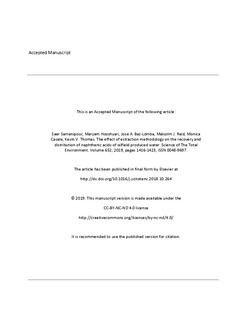| dc.contributor.author | Samanipour, Saer | |
| dc.contributor.author | Hooshyari, Maryam | |
| dc.contributor.author | Baz-Lomba, Jose Antonio | |
| dc.contributor.author | Reid, Malcolm James | |
| dc.contributor.author | Casale, Monica | |
| dc.contributor.author | Thomas, Kevin V | |
| dc.date.accessioned | 2019-09-24T12:38:46Z | |
| dc.date.available | 2019-09-24T12:38:46Z | |
| dc.date.created | 2019-03-28T12:52:55Z | |
| dc.date.issued | 2019 | |
| dc.identifier.citation | Science of the Total Environment. 2019, 652, 1416-1423. | nb_NO |
| dc.identifier.issn | 0048-9697 | |
| dc.identifier.uri | http://hdl.handle.net/11250/2618532 | |
| dc.description | Embargo until 26 Oct 2020 | nb_NO |
| dc.description.abstract | Comprehensive chemical characterization of naphthenic acids (NAs) in oilfield produced water is a challenging task due to sample complexity. The recovery of NAs from produced water, and the corresponding distribution of detectable NAs are strongly influenced by sample extraction methodologies. In this study, we evaluated the effect of the extraction method on chemical space (i.e. the total number of chemicals present in a sample), relative recovery, and the distribution of NAs in a produced water sample. Three generic and pre-established extraction methods (i.e. liquid-liquid extraction (Lq), and solid phase extraction using HLB cartridges (HLB), and the combination of ENV+ and C8 (ENV) cartridges) were employed for our evaluation. The ENV method produced the largest number of detected NAs (134 out of 181) whereas the HLB and Lq methods produced 108 and 91 positive detections, respectively, in the tested produced water sample. For the relative recoveries, the ENV performed better than the other two methods. The uni-variate and multi-variate statistical analysis of our results indicated that the ENV and Lq methods explained most of the variance observed in our data. When looking at the distribution of NAs in our sample the ENV method appeared to provide a more complete picture of the chemical diversity of NAs in that sample. Finally, the results are further discussed. | nb_NO |
| dc.language.iso | eng | nb_NO |
| dc.publisher | Elsevier | nb_NO |
| dc.rights | Attribution-NonCommercial-NoDerivatives 4.0 Internasjonal | * |
| dc.rights.uri | http://creativecommons.org/licenses/by-nc-nd/4.0/deed.no | * |
| dc.title | The Effect of Extraction Methodology on the Recovery and Distribution of Naphthenic Acids of oilfield Produced Water | nb_NO |
| dc.type | Journal article | nb_NO |
| dc.type | Peer reviewed | nb_NO |
| dc.description.version | acceptedVersion | nb_NO |
| dc.source.pagenumber | 1416-1423 | nb_NO |
| dc.source.volume | 652 | nb_NO |
| dc.source.journal | Science of the Total Environment | nb_NO |
| dc.identifier.doi | 10.1016/j.scitotenv.2018.10.264 | |
| dc.identifier.cristin | 1688534 | |
| cristin.unitcode | 7464,30,21,0 | |
| cristin.unitcode | 7464,20,13,0 | |
| cristin.unitname | Miljøkjemi | |
| cristin.unitname | Økotoksikologi | |
| cristin.ispublished | true | |
| cristin.fulltext | preprint | |
| cristin.qualitycode | 2 | |

